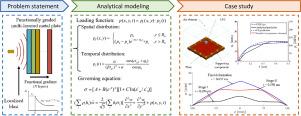Dynamic response of functionally graded multi-layered plates to localised blasts
IF 9.4
1区 工程技术
Q1 ENGINEERING, MECHANICAL
International Journal of Mechanical Sciences
Pub Date : 2025-10-10
DOI:10.1016/j.ijmecsci.2025.110929
引用次数: 0
Abstract
Functionally graded multi-layered metallic (FGMM) plates integrated with graduation of constituent, light-weight, high-strength and customised properties are highly desired as blast-resistant structures. Meanwhile, very limited investigation on their dynamic response to localised blast loading involving large deflection has been reported. Here, we develop an analytical model to investigate the large inelastic deformation response of FGMM plates under localised air blast loading. Nonlinear loading and constitutive characteristics, such as the localised variability and exponential decay shape from a close-in blast, as well as the effects of strain rate sensitivity and strain hardening, were considered. Extended Hamilton’s principle is applied to derive the governing equation of motion for FGMM plates. Blast tests were performed to validate the analytical predictions of the temporal evolution of transverse central deflection and permanent transverse deflection. The analytical model is used to discuss a number of issues relevant to the dynamic response of FGMM plate, including the effect of loading distribution, influence of different constitutive behaviours, energy partitioning, blast resistance and deformation mechanism. Results in this work show that FGMM plate has superior blast resistance (with 14.9% less permanent transverse deflection) to that of a monolithic steel plate with identical weight, which was attributed to the higher effective specific strength. Localised explosive action triggers a distinct initial bulging deformation phase, resulting in significant external work done. This study provides new insights into the dynamic response of the blast-loaded FGMM plates, while further highlighting their potential in the application of blast-resilient systems.

功能梯度多层板对局部爆炸的动力响应
功能梯度多层金属(FGMM)板集成了成分梯度、轻量、高强度和定制特性,是高度需要的防爆结构。同时,对它们在局部大挠度爆炸载荷下的动力响应进行了非常有限的研究。在这里,我们开发了一个分析模型来研究局部空气爆炸载荷下FGMM板的大非弹性变形响应。考虑了非线性载荷和本构特性,如近距离爆炸的局部变异性和指数衰减形状,以及应变率敏感性和应变硬化的影响。应用扩展哈密顿原理推导了FGMM板的运动控制方程。通过爆炸试验验证了横向中心挠度和永久横向挠度的时间演化分析预测。利用该解析模型讨论了与FGMM板动力响应有关的一系列问题,包括荷载分布的影响、不同本构行为的影响、能量分配、爆炸阻力和变形机制。研究结果表明,FGMM板的抗爆破性能优于相同重量的整体钢板,其永久横向挠度减少14.9%,这是由于其具有更高的有效比强度。局部爆炸作用触发一个明显的初始膨胀变形阶段,导致大量的外部工作完成。该研究为爆炸载荷下FGMM板的动态响应提供了新的见解,同时进一步突出了其在爆炸弹性系统中的应用潜力。
本文章由计算机程序翻译,如有差异,请以英文原文为准。
求助全文
约1分钟内获得全文
求助全文
来源期刊

International Journal of Mechanical Sciences
工程技术-工程:机械
CiteScore
12.80
自引率
17.80%
发文量
769
审稿时长
19 days
期刊介绍:
The International Journal of Mechanical Sciences (IJMS) serves as a global platform for the publication and dissemination of original research that contributes to a deeper scientific understanding of the fundamental disciplines within mechanical, civil, and material engineering.
The primary focus of IJMS is to showcase innovative and ground-breaking work that utilizes analytical and computational modeling techniques, such as Finite Element Method (FEM), Boundary Element Method (BEM), and mesh-free methods, among others. These modeling methods are applied to diverse fields including rigid-body mechanics (e.g., dynamics, vibration, stability), structural mechanics, metal forming, advanced materials (e.g., metals, composites, cellular, smart) behavior and applications, impact mechanics, strain localization, and other nonlinear effects (e.g., large deflections, plasticity, fracture).
Additionally, IJMS covers the realms of fluid mechanics (both external and internal flows), tribology, thermodynamics, and materials processing. These subjects collectively form the core of the journal's content.
In summary, IJMS provides a prestigious platform for researchers to present their original contributions, shedding light on analytical and computational modeling methods in various areas of mechanical engineering, as well as exploring the behavior and application of advanced materials, fluid mechanics, thermodynamics, and materials processing.
 求助内容:
求助内容: 应助结果提醒方式:
应助结果提醒方式:


